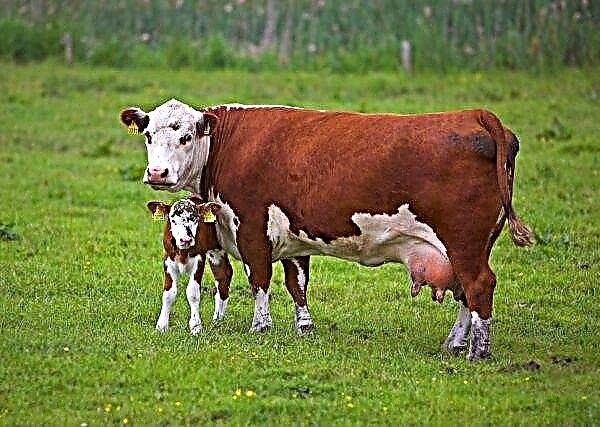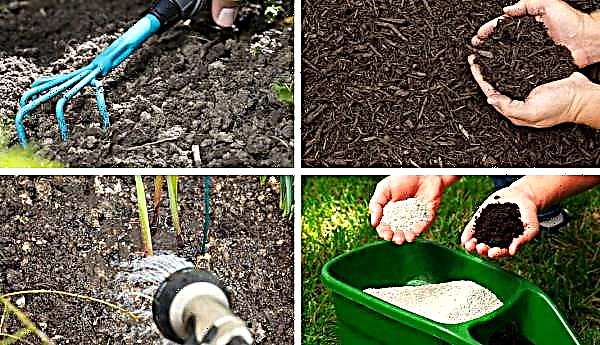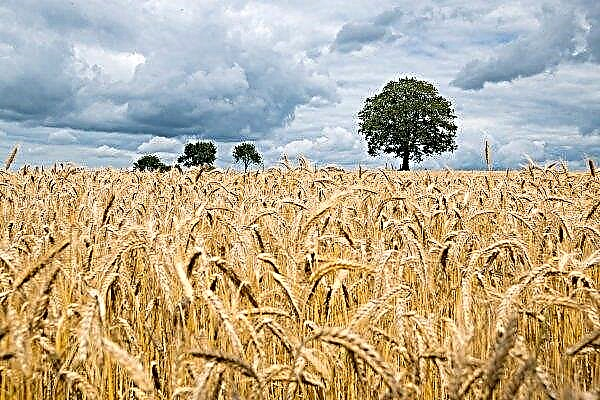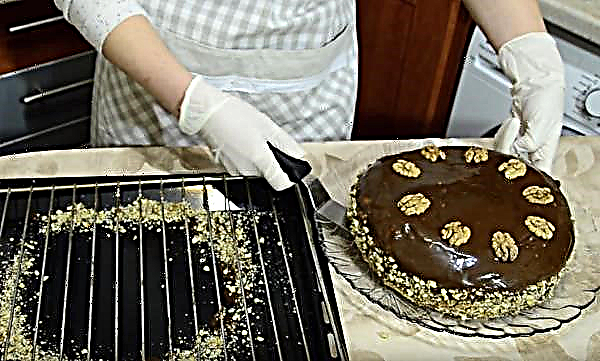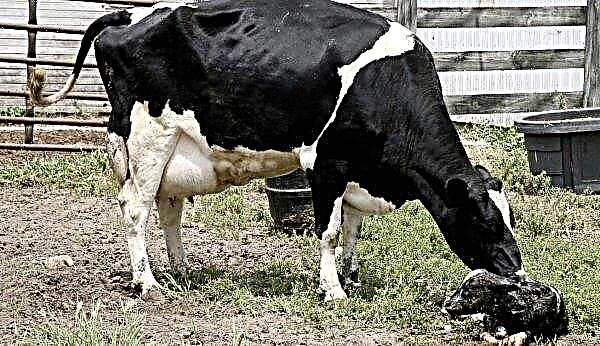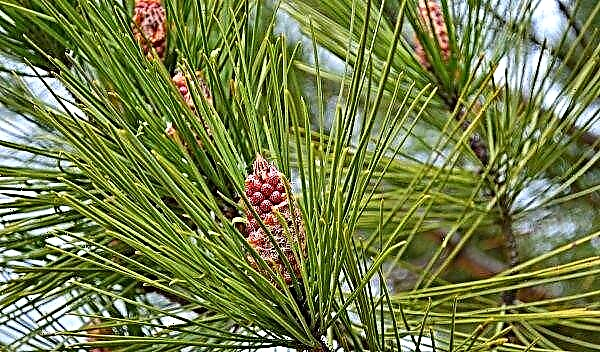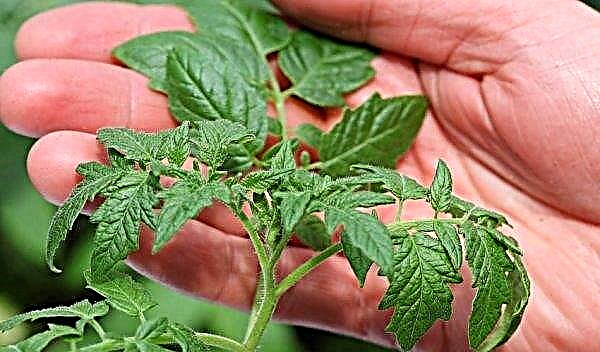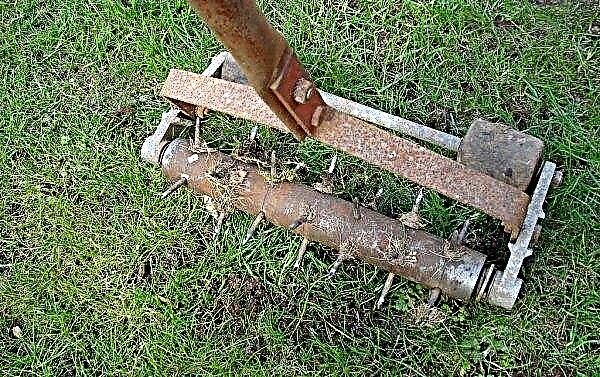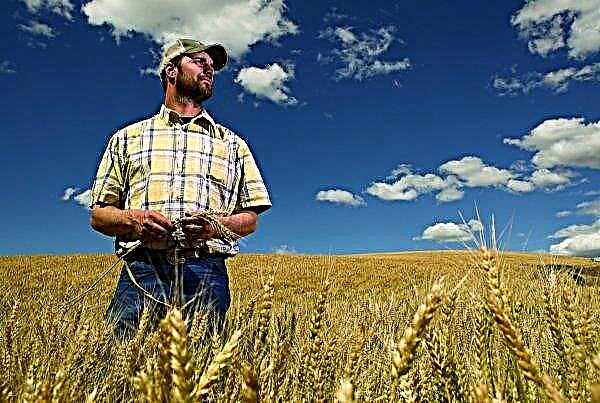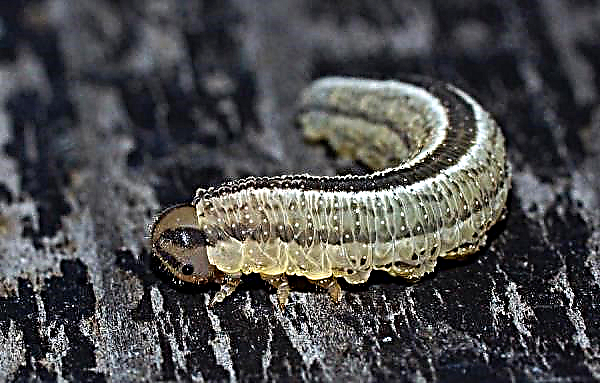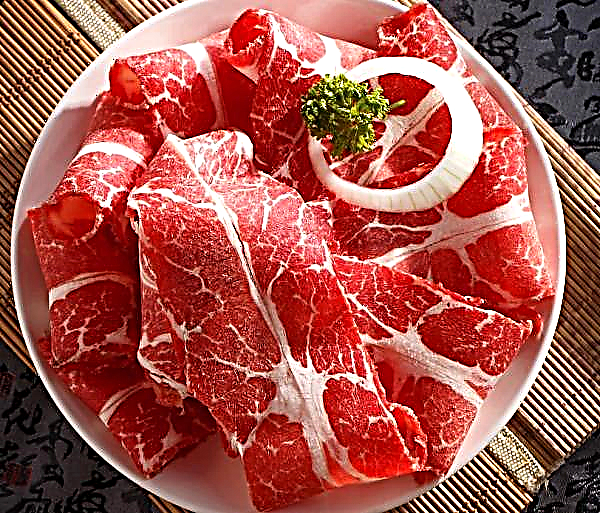Pruning fruit trees is an important procedure that is carried out regularly if you want to get a good crop and maintain the plant in a healthy condition. Consider the features of pruning apples in detail, why it needs to be done and how to do it correctly at home.
Did you know? The oldest fruiting apple tree in the world is a tree planted in the vicinity of New York more than 380 years ago..
Why pruning an apple tree in spring
There are a number of reasons for spring pruning:
- Young plants undergo forming pruning, which is carried out to form the correct crown, which will allow you to adjust the uniform ovary and ripening of apples on the branches, without overloading individual parts of the plant.
- Sanitary pruning of adult apple trees is carried out in order to remove diseased, old, damaged and weak branches on the tree, which interfere with the normal growth of the plant and reduce yield.
- A correctly carried out procedure stimulates the growth of the trunk, which is very important for trees with a consistently high yield, since only strong plants can withstand the pressure that the fruits create on the branches.
- If the crown is correctly formed, a sufficient amount of sunlight and fresh air, which are necessary for the normal ripening of apples, and nutrition of the leaves, will get inside. The anti-aging pruning of old apple trees is necessary in order to restore fruiting function, stimulate the growth of new young fruit shoots.
General principles of pruning apple trees:
- Consider the main advantages of pruning an apple tree in spring:
- After wintering on a tree, you can see frozen and dead branches that are immediately removed, so in the future the tree will not spend the juices to restore them, but will direct all its efforts to building up young fruit shoots.
- Slices on trees after spring pruning heal very quickly, since during this period the concentration of useful elements in the plant sap is maximum.
Important! It is spring pruning of apple trees that is more preferable, as it is considered as sparing as possible (it causes a minimum of damage to the plant).
- There are also certain disadvantages of performing the procedure in the spring:
- It is important to guess the right moment for the procedure, so as not to injure the plant and stimulate the rapid healing of sections.
- It is necessary to carry out pruning at certain times, which depend on the variety and period of the growing activity of the tree, which makes it impossible to prune the entire garden at a time.
- Such pruning is not carried out on trees that are able to form flower buds on last year's branches.
Video: Spring pruning apple trees
Terms and conditions of trimming
It is very important to carry out spring pruning on time, since the further growth of young shoots, the healing of slices and the quality of fruiting directly depend on the correctly selected time period for the procedure.
As soon as the frosts recede, the air temperature stabilizes and its further decrease is not expected (not lower than -5 ° C) - this is the very time for pruning apple trees. It is very important not to miss the right time for the procedure and to have time before the kidneys swell.
If the kidneys wake up, then time is lost, and it is better to carry out the procedure in the fall. Failure to comply with recommendations and pruning after awakening the tree entails sad consequences - poor healing of the slices, violation of the fruiting time, low productivity.
Did you know? Homeland of the Apple Tree — territory of modern Kazakhstan, and the world leader in growing apples — China.
Pruning
Before the procedure, it is important to prepare in advance so that the pruning is safe for the tree and the cuts are quickly tightened. Consider how to prune apple trees and what means of processing slices is better to use.
Tools
The procedure for trimming the branches of a plant is carried out using a large garden knife or saw, depending on the thickness of the shoot to be removed. To remove the tops of the shoots it is convenient to use a pruner. All tools must be sharpened and processed with any antiseptic. As an antiseptic, you can use a 5% formalin solution.

If a saw is used for cutting, choose a tool with small teeth, which will minimize injury to the plant. Before use, check the serviceability of tools, for example, a saw with spaced teeth should not be used for cutting, it will not only damage the tree, but will also be unsafe for the gardener.
Processing facilities
If the diameter of the obtained sections exceeds 1 cm, it is worth taking care of the treatment of wounds. For good healing of sections, it is usually recommended to use special formulations purchased in the store. They consist of fungicides, insecticides and substances that contribute to the rapid healing of sections.
It is better to give preference to professional preparations, such as:
- "RunNet";
- "Blagosad";
- "Etisso Lac Balm."

If it is not possible to purchase special products, you can prepare the mixture yourself.
There are many recipes for cooking at home, so consider a few of the best:
- In 6 parts melted paraffin, crushed rosin is added - 3 parts. The mixture is brought to a boil and 2 parts of sunflower oil are added, left on the stove for 10 minutes and used as intended after cooling.
- Mix 1 part of pork fat, 4 parts of rosin and 1 part of wax, melt over low heat, constantly stirring. After dissolution, leave on the stove for another 20 minutes and use when the product has completely cooled.
Cropping patterns
Depending on the objectives of trimming the tree, choose the appropriate scheme.
Important! Sometimes pruning schemes are combined for greater efficiency, especially if you need to prune old trees.
There are 2 ways to trim:
- thinning - involves the complete removal of some shoots, which contributes to better illumination of fruit branches. When thinning, the shoot is removed, leaving a small knot. Such pruning stimulates the growth of the tree in height and width, while lateral branching in the crown is not observed;
- shortening - involves the partial removal of shoots that have grown over the year. This method is the most common and used most often. Thanks to this pruning, the shortened branches become thicker, which stimulates the growth of a large number of young fruit shoots.
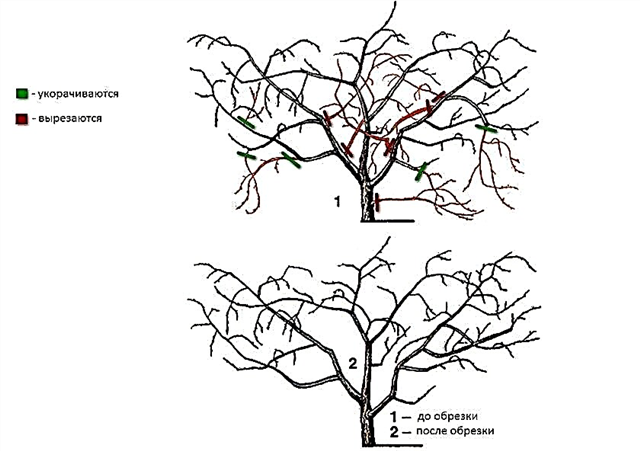
Shortened pruning helps to slow down the growth of the tree in height and width, but stimulates the accelerated growth of the side branches.
Pruning young and adult apple trees
Depending on the age, type and method of growing the tree, the pruning procedure will differ, therefore, we will consider how to properly remove the branches, taking into account the above factors.
Annual seedling
A young apple tree is cut in order to form a high-quality crown of the tree in the future, which will allow holding a large amount of ovary without overloading the tree. Pruning an annual apple tree is performed immediately after planting in the ground.
The procedure for removing part of the trunk is as simple as possible:
- The top of the seedling should be trimmed so that its height is 70–80 cm. A similar method of removing the trunk will stimulate the growth of lateral branches this year.
- If lateral shoots remain on the apple tree after trimming the trunk, they are cut off, leaving 20–25 cm (3 to 5 buds).
- If the remaining shoots on the apple tree grow at an acute angle, they should be completely removed - such branches will not be able to form a good large crown.

Two year old seedling
The two-year-old seedling already has a grown strong trunk, several skeletal branches and many small processes that must be removed in a timely manner.
The procedure for pruning a young apple tree is as follows:
- On the apple tree, from 3 to 5 of the strongest and correctly growing (at right angles to the trunk) branches are selected, the rest are completely removed with a pruner or garden knife.
- In addition to the lateral branches, they also pay attention to the trunk, shorten it a bit, leaving 5 more buds than on the side shoots.
- When forming the crown, pay attention to the length of the side shoots, the lower tier should be cut so that its length is 30 cm longer than the upper tier of the branches. At the same time, each branch is cut by at least 25 cm.

Fruit tree
At the age of 3-4 years, the apple tree usually begins bearing fruit, at which time the crown should already be well formed, therefore, the main attention is paid to sanitary pruning and clarification of the thickened plant for free access of sunlight and fresh air into the crown.
The main attention is paid to the branches growing inside the crown, they should be removed completely. It is better to remove several of the largest branches at once than many smaller ones. Also, on the fruiting apple tree, all shoots are shortened by 15-30 cm depending on their length (very long ones shorten more, short ones - less).Important! It is worth remembering that trees that have just begun bearing fruit do not tolerate the removal of a large number of branches, so the procedure is performed as carefully as possible.
 1 - before trimming; 2 - after pruning. Sanitary pruning of the fruiting apple tree involves the removal of diseased, dry and damaged branches in order to save the tree from a meaningless waste of energy on their nutrition and restoration.
1 - before trimming; 2 - after pruning. Sanitary pruning of the fruiting apple tree involves the removal of diseased, dry and damaged branches in order to save the tree from a meaningless waste of energy on their nutrition and restoration.Rejuvenation of an old tree
You can rejuvenate an old apple tree in several stages:
- Initially, the crown of the tree is reduced. To do this, 2–2.5 cm recede from the lower tier and cut off the remainder of the trunk. They are treated with a special tool for better wound healing.
- Completely cut off all branches that do not bear fruit. Thin shoots, the thickness of which does not exceed 2 cm, are shortened as much as possible, their length should be no more than 15 cm.
- Fruiting shoots should also be cut, removing up to 40 cm of the length of each branch.
- The thickened crown is cleaned from growing inward, sick, weak, pests and damaged branches.

Trellis Trees
The advantage of trellis trees is compactness, therefore pruning is mainly aimed at preserving this feature. Young trees are pruned once a year before fruiting and form a “skeleton”, which in the future will become the basis for fruit branches.
Check out

In the second year, when skeletal branches appear, they are guided along the trellis, tied in several places, and cut to 1/3 of the length, removing all other shoots.
Pruning is done with a sharp sector or a garden knife. Before fruiting, pruning is carried out in the same way as in the second year of cultivation, all shoots are shortened, excess ones are removed and the trunk is cut by 30–40 cm.
When the apple tree begins to bear fruit, pruning is carried out 2 times a year - in early spring and summer.
Spring pruning is not very different from that which was carried out earlier, all diseased, damaged, weak and incorrectly growing shoots are removed, all other branches are shortened by 20 cm.
In summer, green mass should be thinned out by cutting young shoots that thicken the crown and removing some of the fruit so that the apple tree does not overload during ripening. In the first year of fruiting, up to 3 fruits should be left on one fruit branch.  Then, every year, small, sick, weak fruits are removed from the tree to free the tree from wasting juices for their nutrition.
Then, every year, small, sick, weak fruits are removed from the tree to free the tree from wasting juices for their nutrition.
Pruning dwarf trees
The procedure for pruning a dwarf apple tree differs from the usual one, therefore, we consider the features of the implementation of manipulation depending on age:
- In the first year of cultivation, pruning of the apple tree is carried out immediately after planting, cutting the trunk at a height of 50 cm.
- In the second year, up to 5 strong shoots will form on the tree, so they are shortened as much as possible, leaving a length of 20 cm. All small shoots are completely cut out, the trunk is shortened by 30 cm.
- In the third and fourth years produce the same pruning as in the second year of cultivation.
- An adult apple tree that has been fruiting is pruned annually. During the procedure, dry, diseased shoots, branches that grow inside the crown, and small shoots are removed so that the tree does not thicken. Skeletal branches also shorten a little, by 15–20 cm.
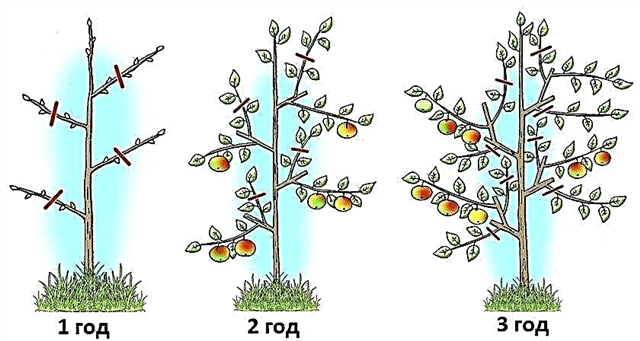
Caring for the apple after pruning
Caring for the apple after pruning consists of regular watering, top dressing, mulching the soil and weeding the trunk circle to loosen the soil and remove weed vegetation, which interferes with the normal nutrition of the roots.
After planting and pruning an annual seedling, the soil is mulched with a thick layer (10 cm) of sawdust or peat in order to retain moisture and prevent the weeds from quickly overgrowing.
The apple tree needs watering once a month, during drought on hot summer days watering is more frequent, it is carried out every 2 weeks. A large amount of water is poured into the trunk circle - from 3 to 6 buckets, depending on the age of the tree.
In autumn, to increase yield next year, you can fertilize the plant with mullein, introducing it under digging. For 1 m² it is worth using up to 8 kg of fertilizer. As the weed vegetation grows, weed control should be carried out along the trunk circle, while loosening the soil for better oxygen access to the roots.
Common Beginner Mistakes
In order for pruning to be effective, it is necessary to adhere to all recommendations for its implementation, but sometimes beginning gardeners, not knowing all the nuances, make serious mistakes.

Consider the most common of them and tips on how to avoid such problems:
- They remove part of the shoot "on the kidney" or leave a large "stump". This can cause rotting of the shoot or penetration into the infection. Trim the shoot should be 2-3 cm above the kidney, making an oblique cut "from the kidney."
- They do not comply with the procedure: cut the branches too early (the trees freeze) or too late when the buds are already swollen (the tree is painfully undergoing late pruning, has poor fruiting and is sick).
- Do not lighten the crown, leaving a large amount of excess growth.
- Remove old branches covered with moss and lichen, which absolutely do not harm the plant. In the case of stable fruiting, such shoots are best left by removing diseased or fruitless shoots.
Did you know? The record-breaking apple is considered to be a fruit grown in 2005 by the Japanese farmer Chisato Iwasaki, its weight was 1.850 kg.
Thus, the process of pruning an apple tree is not difficult if you follow the recommendations for the procedure, take into account the age of the tree and follow the deadlines. Annual pruning not only stimulates high yields, keeps the tree healthy, but also simplifies plant care and harvesting.



